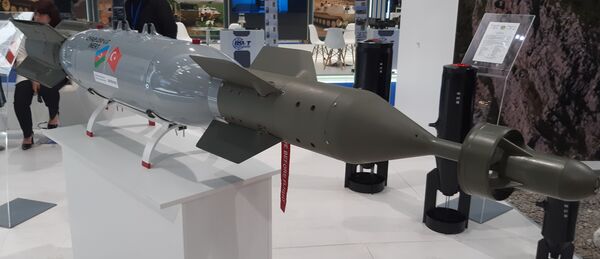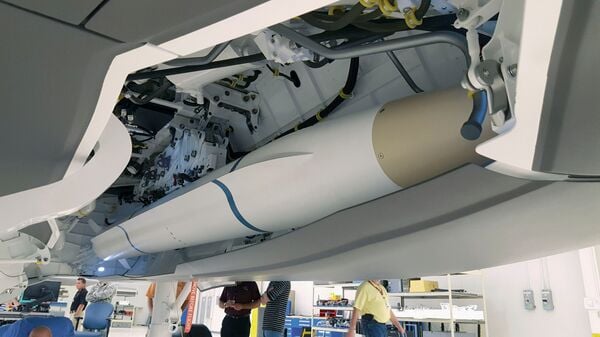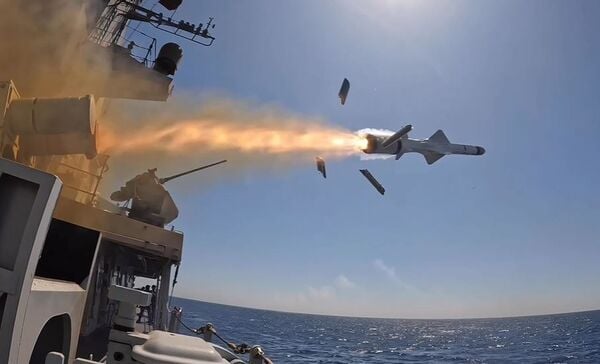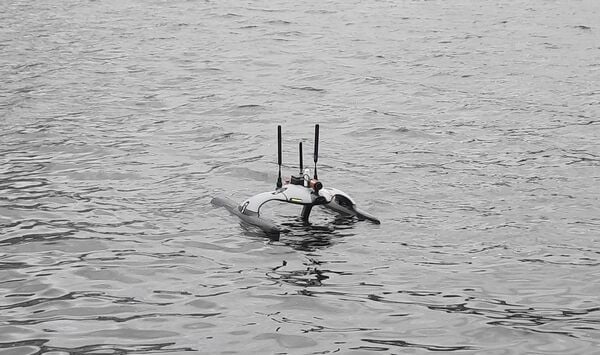- About
- Intara
- Capabilities
- Advisory
- Resources
- News
- Store
Update – ADEX 2022: Latest member of QFAB series adds laser guidance
16 September 2022
by Huw Williams


The QFAB-250 LG features a laser-guidance system as part of its applique kit. (Janes/Huw Williams)
The Azerbaijan Ministry of Defence Industry unveiled the latest member of its QFAB (also known as GFAB) series of general-purpose bombs at the ADEX 2022 exhibition in Baku on 6 September.
According to ministry officials, the new bomb – designated QFAB-250 LG – was developed in collaboration with Turkey's Aselsan.
The QFAB-250 LG is intended to provide enhanced accuracy over the standard QFAB bombs through an applique kit that includes a laser-guidance system and control surfaces. The guidance system is fitted to the nose of the bomb, and control surfaces in the nose and rear.
Information released by the ministry claims a circular error probable of up to 10 m, and the ability to drop the bomb from a maximum altitude of 12,000 m (39,370 ft) and a speed of up to Mach 0.9 (1,100 km/h).
The addition of the guidance kit adds 20 kg to the 250 kg of the standard bomb. The QFAB-250 LG maintains the use of high-explosive fragmentation, and it measures 3,300 mm in length and 325 mm in diameter.
Netherlands, Poland approved for AARGM-ER SEAD/DEAD missiles
25 April 2024
by Gareth Jennings


An AARGM-ER seen being test fitted into the internal weapons bay of an F-35 combat aircraft. The US has approved the sale of the missile to both the Netherlands and Poland. (Northrop Grumman)
The US government has approved the sale of the Northrop Grumman AGM-88G Advanced Anti-Radiation Guided Missile – Extended Range (AARGM-ER) to the Netherlands and Poland.
Announced by the US Defense Security Cooperation Agency (DSCA) on 24 April, the approvals cover 265 of the suppression of enemy air defences/destruction of enemy air defences (SEAD/DEAD) missiles for the Netherlands for approximately USD700 million, and 360 missiles for Poland for approximately USD1.275 billion. Both approvals cover related equipment, training, and support.
“The proposed sale will improve the Netherlands'/Poland's capability to meet current and future threats by strengthening its self-defence capabilities to suppress and destroy land- or sea-based radar emitters associated with enemy air defences. This capability denies the adversary the use of its air-defence systems, thereby improving the survivability of the Netherlands'/Poland's tactical aircraft,” the DSCA said of both approvals.
Indonesia to restart procurement process for more Exocet missiles
18 March 2024
by Ridzwan Rahmat


An Exocet MM40 Block 3 missile being launched from an Indonesian Navy Bung Tomo-class frigate. The country's latest attempt to replenish its stock of Exocet missiles has been delayed by non-conformity issues. (Indonesian Navy Armada I)
Indonesia will have to restart a process to replenish the country's stock of MBDA Exocet MM40 Block 3 anti-ship missiles after an earlier attempt failed because of licensing non-conformity issues.
A 24 February letter from the Indonesian Ministry of Finance's (MoF's) Directorate General of Budget Financing and Risk Management sent to various departments at the country's Ministry of Defense (MoD) confirmed that a previously granted permission to procure the missiles with foreign loans has now lapsed.
A copy of the letter was provided to Janes on 18 March by sources close to the procurement process.
In the letter, the MoF advised the respective MoD departments to resubmit a request for a total of three programmes for which the permission to take on foreign loans has lapsed, including the Exocet missile procurement.
EvoLogics preparing further deliveries of Sonobot USVs to Ukrainian armed forces
18 March 2024
by Neil Dee


EvoLogics Sonobot 5 USV being demonstrated at Oceanology International 2024 in London on 13 March. (Janes/Neil Dee)
German company EvoLogics is planning to deliver a further batch of Sonobot unmanned surface vehicles (USVs) to the Ukrainian armed forces. EvoLogics CEO Fabian Bannasch told Janes at Oceanology International 2024, held in London on 12–14 March, that his company is “currently preparing a fourth configuration of Sonobot with enhanced underwater data networking and positioning capabilities in order to guide and support complex underwater missions with dive teams, and AUVs [autonomous underwater vehicles] where the Sonobot will be the gateway buoy at the surface” for the Ukrainian armed forces. Sonobots are a family of small USVs of about 1.3 m in length that can be folded and transported by a single person.
The Azerbaijan Ministry of Defence Industry unveiled the latest member of its QFAB (also known as GF...
Latest Podcasts
Iran Israel analysis
In this podcast Janes analysts discuss the Iranian attacks on Israel on the 14 April. They highlight the military systems used by Iran and the performance and impact of these on Israel. They also discuss the implications of this attack goi...
Listen nowJanes Case Studies
Using Janes Intara to build a common intelligence picture: Russian build up on the Ukrainian border
View Case StudyNews Categories
 Weapons Details
Weapons Details